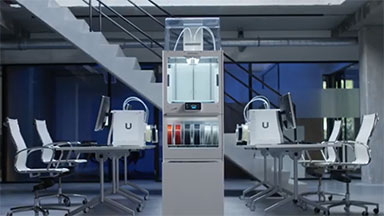Bunkspeed’s New hyperShot Simplifies the Product Design Process
An image-rendering system that can bring in 3D computer aided design data for photorealistic images in seconds.
October 1, 2007
By Al Dean
Product development technology is rapidly gaining maturity and many, particularly those new to the world of 3D, are wondering where next — where else can they derive benefit from the 3D data they create?
One of the most commonly discussed processes is that of rendering — the creation of photorealistic images to show the products we’re developing, long in advance of actual production or even prototyping.
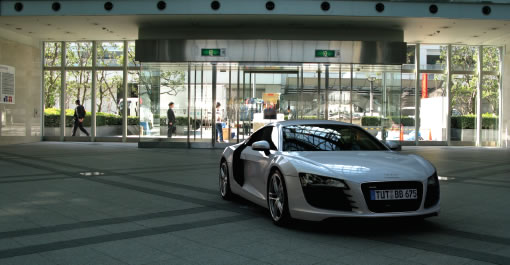 hyperShot from Bunkspeed is an image-rendering system that takes 3D solid model data and creates stunningly photorealistic images quickly and easily by removing the key barriers of lighting and scene setup,material assignment, and rendering calculation times. |
But how many of us actually take advantage of the rendering tools commonly available within our workhorse CAD tool? Perhaps not as many as should — especially since real benefits can be derived. As an aid to design review or client-customer presentation, a photorealistic image is priceless in terms of communicating what you’re discussing.
As a pre-manufacture or pre-prototype marketing aid, photorealistic images can assist in generating market interest or getting your product ordered or sold before it actually arrives on the production line.
Bottlenecks Identified
So why aren’t more people using this technology? The answers are many. For some, it’s not required; for the remainder, research shows that there are several key bottlenecks putting people off, even holding back those who have already adopted the technology.
The setup of materials and scenery is painful in most rendering applications. Alongside this, the creation of an accurate lighting setup is just as important to create truly stunning visuals. And of course, there’s the old standard of calculation times. So, what to do?
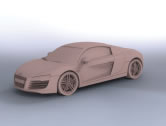 The first step in the process is to import your 3D geometry, either in IGES, STEP, OBJ, or SolidWorks native part or assembly format. | 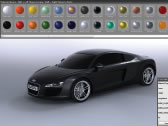 You then use the simple strip of materials to assign color and surface texture — then adapt them to your requirements and color schemes. | 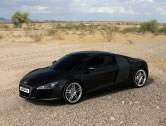 To put your product into context, you can then add a backplate image and choose a high dynamic range map to provide the lighting. |
Well, a new answer to that question is found in hyperShot from Bunkspeed of Los Angeles, CA. Now, for those unfamiliar with the name (as I was), Bunkspeed has been very active in the automotive realm for many years, but with the release of hyperShot, it is aiming fairly and squarely at the mainstream market.
hyperShot is an image-rendering system that lets you bring in your 3D CAD data and create stunning (as I’m sure you’ll agree) photorealistic images — and lets you do so in a highly compressed time frame. Data can be imported via IGES, STEP, or OBJ — a widely supported format in the 3D world — alongside SolidWorks native parts and assemblies.
The Time Factor
You’ll notice that the images associated with this review don’t show a user interface, and for good reason—there’s isn’t one in the traditional sense.
Starting up the application, you’re presented with a large window (more on size later) and a simple dialog containing six icons—and these represent the workflow. You begin by importing the CAD data using IGES, STEP, OBJ, or using the SolidWorks native data importer.
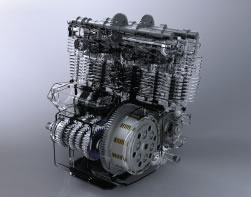 The use of transparent materials can be used to great effect as illustrative imagery — here the cylinder block and head have been made transparent to allow the viewer to see the engine internals. | 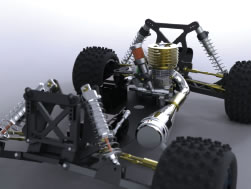 Depth of Field gives you the ability to defocus non-critical areas and concentrate the viewer’s eye on the details you want. It adds greater realism if used subtly. |
The next step is to assign materials to your parts. Now, in many rendering systems (both stand-alone and CAD integrated) this is a painful process if you want to step outside of the standard built-in materials. hyperShot is supplied with a library of materials that are immediately usable and cover the basics, from various metals, plastics, and other textures, to car paint effects and such.
To apply them, you hit the M key, which brings up a strip of the materials, and using a combination of keys and the mouse buttons, you apply them to the various parts. To change a material, you double-click the part and edit the material param-eters, perhaps tailoring color schemes using RGB values, as well as reflectance, bump, and such. Also, in the next release (due before the end of this year), you can quickly add materials to the library to avoid editing them individually.
What you’ll notice is that as you add the materials, the display updates incredibly quickly and, within seconds, you have a fully ray-traced image onscreen. As you move the model, and change the materials, the display updates in real time and you can instantly see the effect of your modifications. This is really key to why hyperShot is a breakthrough product. While in traditional rendering tools, you’d have to wait for a re-render with each change, here you can see the model in glorious technicolor within seconds!
Images in High Dynamic Range
Once your model is set up with materials, the next step is to choose the environment in which you want the part placed. Here is the point where hyperShot’s new nature shows. The whole system is based around the use of High Dynamic Range (HDR) images. For those unfamiliar with this, HDR images are a method of storing a huge amount of information about an environment. Not only its appearance but — more importantly in many cases — the lighting conditions. They are captured using a number of devices, leader of which is SpheronVR.
The High Dynamic tag indicates that the images output from such devices capture much light intensity to a much higher degree — as a result, the lighting in your scene is more closely matched to the real world, meaning you get more accurate lighting, shadows, and reflections.
The hyperShot system is supplied with a number of different HDR environment images, from the basic studio setup through some showing Bunkspeed’s automotive background as well as a kitchen.
Bunkspeed also sells additional HDRs on its website and there are a number of other sources on the Web, like DoschDesigns.com and a new service about to be launched this year by 3six0 of the United Kingdom that offers a huge royalty-free library of HDR images for a very low cost or may offer an even cheaper monthly subscription plan.
The next step, if you need to, is to choose a backplate image. While HDR maps can provide a quick way to create the scene and lighting information, if you want to place your product into a scene, a backplate offers a different method. By using high-quality images, then positioning the model appropriately, you can create the types of images you see here in a very short space of time.
Lights, Camera, Action
Now, as you should be aware, hyperShot works in real time. Even on my dated laptop, it runs near real time; on a decent workstation-class machine, it truly sings, particularly on multiprocessor or multicore machines (as the calculation is processor-, rather than graphics-dependent). The lighting and scene setup is a snap with the combination of HDR environments and backplate images plus offers full control over gamma and exposure, and camera focal length (depth of field provides that ‘distant-objects-blurred-effect’ to increase realism).
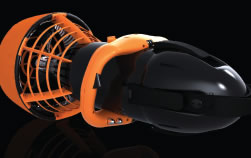 Although Bunkspeed’s background is automotive design, the pricing and usability of hyperShot means that you can use it to create stunning imagery of almost any product.The system can be used to generate all manner of imagery for any number of purposes. |
What this means is that rendering becomes a process that you can carry out in a very short space of time (think minutes, rather than hours). You can create truly stunning imagery and use that as part of your product development process. Designs can be made on a product under development based on photorealistic images, rather than ambiguous CAD models, drawings, and such, allowing everyone involved in the process to see exactly what your design team in envisioning. Once the design is frozen, the same assets can be reused to provide pre-marketing materials without any additional work needed or lengthy calculation processes.
hyperShot is priced in the same manner as digital cameras. Essentially, everything we’ve discussed here is available in all flavors of the system. What differs is the resolution that you can work in, both in real time and then output final renders to.
The starting variant is hyperShot Web, which runs at 800 x 450 pixels in real time and outputs to the same resolution — and is priced at an incredible $195. Next up, hyperShot HD runs at 1920 x 1080, and outputs up to 4.1 megapixels, and is priced at $995. Topping out the range is hyperShot Pro, which is unlimited in both real-time and output resolution, and costs $12,995.
All data is transferable between the variants, so if you have a range of lower-end seats, if you do need the big renders, then just a single Pro license would suffice.
Final Word
Bunkspeed is developing the tool at an incredible rate, with texture mapping and custom materials. But even in this first release, it’s clear that hyperShot is an incredible piece of technology, one that changes the game as far as rendering is concerned. What’s interesting is its place in a business or process context. By removing the key barriers of lighting and scene setup, material assignment, and rendering calculation times, it makes such technology available and usable as a part of the decision-making process and, as such, it can prove its worth as soon as you create that first image. Other than that, for those into rendering and visualization, I do have to warn you: it’s highly addictive.
hyperShot Bunkspeed
Los Angeles, CA
Al Dean is technology editor at MCAD Magazine, a UK product development and manufacturing technology journal (mcadonline.com) and is editor of Prototype magazine. You can send comments about this article to DE-Editorsmailto:[email protected].
Subscribe to our FREE magazine, FREE email newsletters or both!
About the Author
DE’s editors contribute news and new product announcements to Digital Engineering.
Press releases may be sent to them via [email protected].





